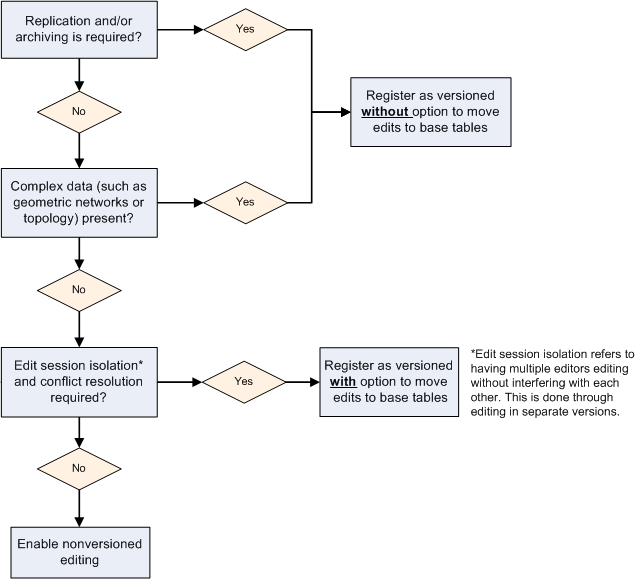|
|
Nonversioned |
Versioned
with the option to move edits to base |
Versioned
without the option to move edits to base |
|---|
| Supported data types |
All data types except feature classes in a topology, geometric network, or terrain
|
All data types except feature classes in a topology, geometric network, or terrain |
All data types
|
| Supported workflows |
Simple workflows
|
Simple and advanced workflows with versions
Not supported: archiving and replication |
Simple and advanced workflows including versions, replication, and archiving
|
| Transaction |
Confined to a single edit session |
Can span many edit sessions |
Can span many edit sessions |
| Supports undo/redo |
No |
Yes |
Yes |
| Supports DBMS data integrity features |
Yes |
When editing the DEFAULT version: Yes, but only when you save
When editing other versions: No |
No |
| Can be read by client applications not created with ArcObjects (third-party applications) |
Yes |
DEFAULT version: Yes
Feature classes in other versions: No
Tables in other versions: Yes, through multiversioned views |
Feature classes: No
Tables: Yes, through multiversioned views |





 To learn more about edit session isolation, see Concurrency and locking.
For more information on the advantages and disadvantages of each editing option, see Data maintenance strategies.
By default, ArcMap edit sessions are set to perform versioned edits. With this setting, you can only edit data that has been registered as versioned. To learn how to set up an edit session to allow nonversioned edits, see Configuring an ArcMap edit session to perform nonversioned edits.
To learn more about edit session isolation, see Concurrency and locking.
For more information on the advantages and disadvantages of each editing option, see Data maintenance strategies.
By default, ArcMap edit sessions are set to perform versioned edits. With this setting, you can only edit data that has been registered as versioned. To learn how to set up an edit session to allow nonversioned edits, see Configuring an ArcMap edit session to perform nonversioned edits.